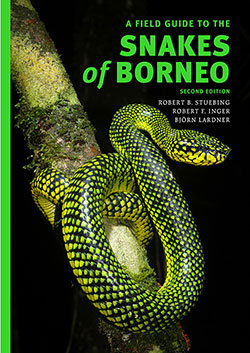A Field Guide to the Snakes of Borneo (second edition)
By Robert B. Stuebing, Robert F. Inger & Bjorn Lardner
 By Robert B. Stuebing, Robert F. Inger & Bjorn Lardner – (2014)
By Robert B. Stuebing, Robert F. Inger & Bjorn Lardner – (2014)
310 pages; gloss art paper, with 287 colour photograph, 11 monochrome illustrated plates & 1 map.
Hard Cover: 22cm x 16cm.
ISBN: 978-983-812-151-4
Natural History Publications (Borneo) Kota Kinabalu
Natural History Publications (Borneo) have published some excellent books over the years, and this one is certainly among their best and possibly the best book on snakes I have read so far. It skillfully covers 153 species known to the island of Borneo and written with minimal scientific language so anyone can read and understand it.
The opening pages cover natural history, evolution, classification and diversity, ecology, snakes and the local people, the wrong persecution of snakes, the dos and do nots if you encounter a snake, hints to help identify poisonous or nonpoisonous snakes, first aid measures in case of the remote chance you are bitten by a snake and very importantly snake conservation and more.
The species are presented alphabetically in families. Each species has its scientific name, author/s, year published, common name, description, scalation, similar species, distribution and habits. The text is enhanced by the inclusion of at least one superb colour photo some species have 2-4 photos, a few species however; three of the subterranean dwelling Blind Snakes and a couple of other rare species are not illustrated with photos. But those that are illustrated – are done so brilliantly!
This is a beautifully presented and very informative guide that will delight any naturalist and its light weight and compact size also makes it useable in the field. However, it being such a nice quality book, one may be reluctant to take it into the field where the chances of it getting wet or scuffed either from rain or simply by slipping over into scrub, a puddle, stream or river are indeed real. No matter, it is most certainly worth buying and if left at home to avoid ‘field scars’, it will be eagerly awaiting you on your return from the field.
Rod Rice
Principal Reviewer
Nature & Travel Books
